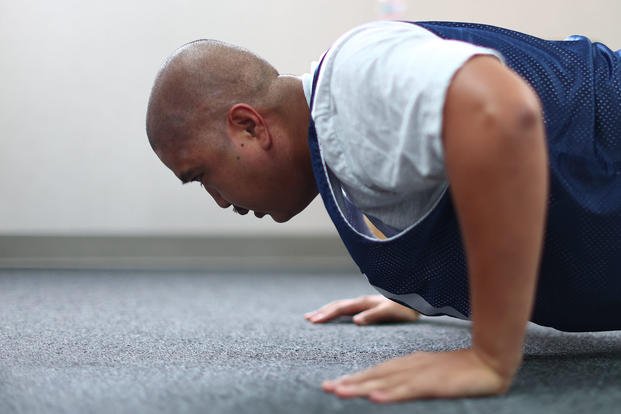Many people get stuck on a performance plateau once they have reached 15 pull-ups and 70 push-ups. Performing at higher levels requires a combination of higher volume repetitions and a mix of weighted versions of the calisthenics.
Once you have mastered your first pull-up and push-up, these strength exercises quickly turn into a muscle stamina and endurance exercise if you're aiming to see numbers as high as 20 pull-ups and 80-100 push-ups on a physical fitness test.
Here is a workout specifically designed for those who can do around 15 pull-ups and 60-70 push-ups on a two-minute fitness test.
Warm up with 55 reps of pull-ups and push-ups. Using the half pyramid model, do the following warmup to prepare yourself to do the entire pull-up pyramid over time.
Pull-up and Push-up Pyramid 1-10 Warmup
There's a 100-meter jog between sets (stop at 10).
Each set looks like this:
1 pull-up and 1 push-up. Short jog with dynamic stretches for 25-50 meters.
2 pull-ups and 2 push-ups. Short jog with dynamic stretches for 25-50 meters.
3 pull-ups and 3 push-ups. Short jog with dynamic stretches for 25-50 meters.
4 pull-ups and 4 push-ups. Short jog with dynamic stretches for 25-50 meters.
5 pull-ups and 5 push-ups. Short jog with dynamic stretches for 25-50 meters.
Keep going until you reach 10 pull-ups and 10 push-ups.
This will total 55 reps each. If this is an easy warmup for you, you are on the right track and should push past the sticking points of your current pull-up and push-up maximum.
Now continue the warmup with a one- to two-mile run.
The following section of the workout is done with a 10- to 20-pound weight vest, depending on your capabilities. All exercises except for the "rest with running" are done with a weight vest (WV) or backpack. For the "rest," run 800 meters at close to your goal-timed run pace.
Goal pace is defined as one minute per mile faster than your current timed run speed. If you currently run an eight-minute mile pace and want to run a seven-minute mile, you need to practice the pace of 1:45 for 400 meters and 3:30 for 800 meters to eventually do a seven-minute mile pace for the distance of your PT test.
This workout described below will accumulate another 75 pull-ups and 150 push-ups with a weight vest. It is fine to take off the weight vest or decrease either the weight or the repetitions to fit your ability, but the goal is to double your pull-up number when doing the push-ups for each type of grip for the pull-up or hand stance for the push-up.
Weight Vest Pull-ups and Weight Vest Push-ups (2x)
Repeat five times.
- Weight vest wide pull-ups: 5 (hands wider than shoulders)
- Weight vest wide push-ups: 10 (hands placed wider than shoulders)
- Weight vest close pull-ups: 5 (hands within shoulder width and almost touching)
- Weight vest close push-ups: 10 (hands within shoulder width and almost touching)
- Weight vest regular pull-ups: 5 (regular grip used for pull-up testing)
- Weight vest regular push-ups: 10 (regular stance used for push-up testing)
- Run: 800 meters at goal mile pace
Grand Finale
If you have anything left, repeat the warmup 1-10 pyramid in reverse order, starting from nine and working your way down to one. This will make the total for your warmup and your cooldown 100 pull-ups and 100 push-ups.
If your arms are done with moving, just go on a cooldown jog or bike of 10-15 minutes.
Granted, it will take some time to build up to these numbers, but that is the beauty of the pyramid. You can go up until you fail, then repeat in reverse order. This pyramid is a great assessment tool to check how you are improving each week with your muscle stamina.
The added weighted versions of these exercises will help you with the strength and endurance combination needed to push yourself off the 15 pull-ups and 65-70 push-ups plateau.
My advice is to do this workout only once a week. However, you will still want to do two more upper-body days spread throughout the seven-day week. We call this one Weight Vest Wednesday. These other two workouts can be a full pyramid with other exercises or a superset using sub-max sets to accumulate volume.
-- Stew Smith is a former Navy SEAL and fitness author certified as a Strength and Conditioning Specialist (CSCS) with the National Strength and Conditioning Association. Visit his Fitness eBook store if you're looking to start a workout program to create a healthy lifestyle. Send your fitness questions to stew@stewsmith.com.
Want to Learn More About Military Life?
Whether you're thinking of joining the military, looking for fitness and basic training tips, or keeping up with military life and benefits, Military.com has you covered. Subscribe to Military.com to have military news, updates and resources delivered directly to your inbox.


















